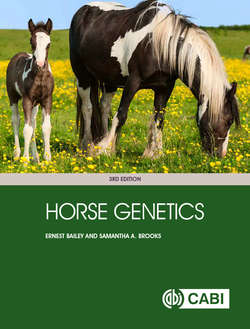Читать книгу Horse Genetics - Ernest Bailey - Страница 7
На сайте Литреса книга снята с продажи.
ОглавлениеPreface to the Second Edition
The preface written for the first edition remains pertinent. At the same time many new discoveries have been made since the first edition of this book was written. Ann Bowling wrote the first edition just when molecular genetics was beginning to be applied to horses. At that time, parentage testing was converting from blood typing technologies to DNA technologies. The mutation had been identified for one coat color gene (extension) and one disease gene (hyperkalemic periodic paralysis in Quarter Horses). Scientists were beginning to construct a genetic map for the horse with hopes of making more discoveries. Indeed, a lot has happened during the intervening 18 years. The entire DNA sequence of a Thoroughbred horse was determined. Molecular genetics has been used to identify many color genes and disease genes. Molecular markers have now replaced blood typing markers for parentage testing. DNA information is providing insights on the domestication of horses and the relationships among breeds. We are beginning to identify specific DNA sequences that influence performance and behavior. Many more horses have now had their entire DNA sequence completed. Genetics has become even more interesting and more useful.
Several years ago, the publishers asked us if we could update the existing text. Initially we declined, responding that so much had happened that it would take more than a revision to produce a useful text. However, when we took a closer look at the book, we were impressed by the organization of the topics and the quality of Ann’s descriptions and explanations.
We did make some changes. We deleted the chapter on gene mapping and added chapters on evolution and genomics. The organization of the color pattern chapters was changed to reflect insights gleaned from molecular genetics. The book contains a large amount of new information and concepts reflecting research during the last decade. Nevertheless, this book remains a revision inasmuch as the organization is true to Ann’s original plan. Her book was a thoughtful challenge to regard genetic questions as puzzles that could be addressed with a wide range of tools.
Ann was fascinated with horse genetics and loved the opportunities she was afforded at the University of California, Davis, to work on all aspects of horse genetics, especially coat color and cytogenetics. She was also an enthusiastic leader in gene mapping research up to the time of her passing. Ann passed away on December 8, 2000 as a result of a massive stroke. The stroke was a complete surprise and Ann was at work discussing research with a colleague when it occurred. However, the greater tragedy was the loss endured by her family. Ann was a wife and mother, devoted to her family. She spoke often and proudly of Michael and Lydia. Together they operated an Arabian Horse breeding farm and were proud of their bloodlines and the accomplishments of their produce.
The spirit of this book reflects Ann’s love of horses and genetics. This book is not necessarily the one she would have written, but Ann contributed to many of the advances described in this book and enjoyed learning of accomplishments by others. We anticipate horse breeders and owners will find the updated text useful. The material in the book includes breeding practices that are products of centuries of experience as well as new information and concepts that will make horsemanship more successful for horse and rider.
The authors are very grateful to several colleagues for critical reading of chapters especially to Drs Teri Lear and Rebecca Bellone who provided extensive help with the chapters on Cytogenetics and Leopard Spotting. Many colleagues also provided images for this book and are identified in the legends accompanying the images.
Ernest Bailey
Samantha A. Brooks
27 November 2012
